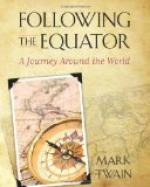it with lurid promises of sudden wealth. It was
well worked in London; and bishops, statesmen, and
all ports of people made a rush for the land company’s
shares. Immigrants soon began to pour into the
region of Adelaide and select town lots and farms in
the sand and the mangrove swamps by the sea.
The crowds continued to come, prices of land rose
high, then higher and still higher, everybody was
prosperous and happy, the boom swelled into gigantic
proportions. A village of sheet iron huts and
clapboard sheds sprang up in the sand, and in these
wigwams fashion made display; richly-dressed ladies
played on costly pianos, London swells in evening
dress and patent-leather boots were abundant, and
this fine society drank champagne, and in other ways
conducted itself in this capital of humble sheds as
it had been accustomed to do in the aristocratic quarters
of the metropolis of the world. The provincial
government put up expensive buildings for its own
use, and a palace with gardens for the use of its governor.
The governor had a guard, and maintained a court.
Roads, wharves, and hospitals were built. All
this on credit, on paper, on wind, on inflated and
fictitious values—on the boom’s moonshine,
in fact. This went on handsomely during four
or five years. Then of a sudden came a smash.
Bills for a huge amount drawn the governor upon the
Treasury were dishonored, the land company’s
credit went up in smoke, a panic followed, values fell
with a rush, the frightened immigrants seized their
grips and fled to other lands, leaving behind them
a good imitation of a solitude, where lately had been
a buzzing and populous hive of men.
Adelaide was indeed almost empty; its population had
fallen to 3,000. During two years or more the
death-trance continued. Prospect of revival
there was none; hope of it ceased. Then, as suddenly
as the paralysis had come, came the resurrection from
it. Those astonishingly rich copper mines were
discovered, and the corpse got up and danced.
The wool production began to grow; grain-raising followed—followed
so vigorously, too, that four or five years after
the copper discovery, this little colony, which had
had to import its breadstuffs formerly, and pay hard
prices for them—once $50 a barrel for flour—had
become an exporter of grain.
The prosperities continued. After many years
Providence, desiring to show especial regard for New
South Wales and exhibit loving interest in its welfare
which should certify to all nations the recognition
of that colony’s conspicuous righteousness and
distinguished well-deserving, conferred upon it that
treasury of inconceivable riches, Broken Hill; and
South Australia went over the border and took it, giving
thanks.




